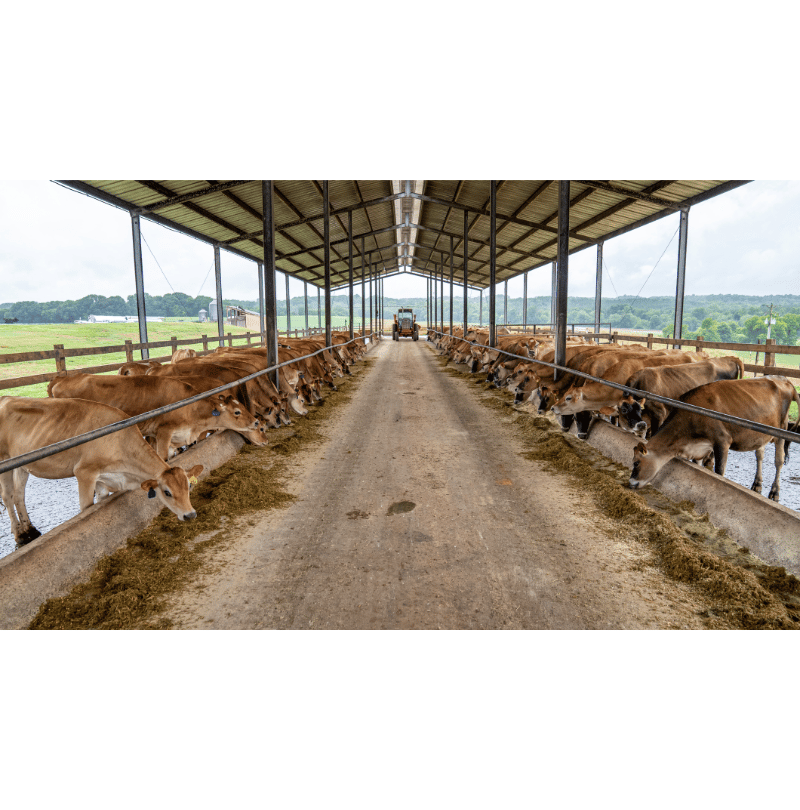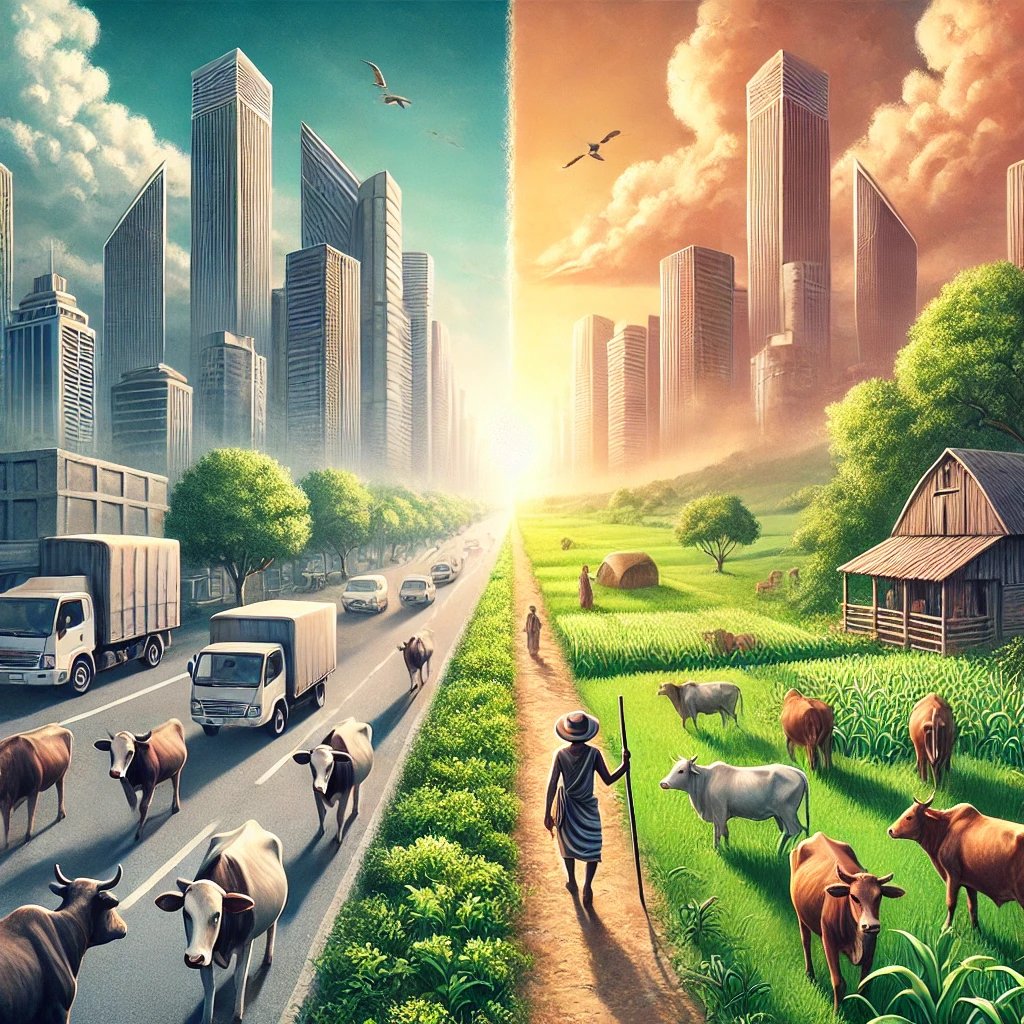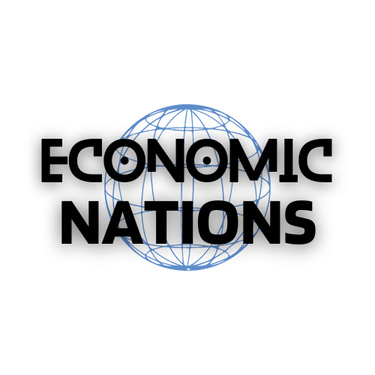Urban Growth vs. Ancient Cattle Wisdom: Can They Coexist?
DISCUSSING ALOUD
11/2/20246 min read


Bureau of Society and Transformation


The Clash of Concrete and Grazing Grounds
The rapid spread of cities has reshaped nearly every aspect of rural life, and nowhere is this more apparent than in the world of cattle rearing. The ancient practice of raising cattle—a tradition deeply intertwined with local landscapes, climates, and cultures—is under severe pressure. As cities spread, grazing lands shrink, and practices honed over centuries are discarded or forgotten. In this tug-of-war between urban sprawl and rural heritage, traditional cattle rearing stands at a crossroads. The question is, can modern tools—like an evolved livestock census—capture and safeguard the invaluable knowledge tied to this practice before it fades?
Imagine a future where urban and rural worlds coexist seamlessly, where cattle rearing is recognized not just as an agricultural endeavor but as a practice of ecological and cultural importance. This future isn’t a given, but with new approaches to livestock census and policy, it could be within reach. Let’s explore how we might use data, policy, and creativity to keep this ancient practice relevant in a rapidly urbanizing world.
The Urban Strain on Cattle Rearing Traditions
When cities grow, the first casualty is often space. Grazing lands and migration routes for pastoral communities are repurposed for housing, highways, or industrial sites, leaving livestock keepers with less and less to work with. But this isn’t just a spatial problem; the effects of urban expansion ripple through environmental, economic, and cultural spheres, eroding the foundation upon which traditional cattle rearing rests.
Shrinking Grazing Lands: Across continents, vast grazing lands have been parceled off, fenced in, or paved over. In India, pastoral communities face restricted access to common grazing lands, disrupting centuries-old cycles of migration and land use. In Africa, the Maasai herders are increasingly pressured to move to smaller plots, compromising not only their traditional practices but also the health of their cattle and the integrity of the ecosystem.
Loss of Indigenous Knowledge: Traditional cattle-rearing practices aren’t just agricultural routines; they’re cultural repositories of medicinal knowledge, environmental stewardship, and sustainable grazing techniques. This knowledge was passed down through generations, but as rural communities fragment and younger generations migrate to cities, these insights are fading. Techniques that once ensured livestock health and environmental harmony are at risk of disappearing.
Environmental Consequences: When cattle rearing shifts from traditional to industrial methods, the environmental impacts are profound. Without grazing cycles and manure that enriches the soil, landscapes become barren, leading to soil degradation and loss of biodiversity. The presence of livestock in traditional settings contributes to soil health, but industrialization often strips this balance away.
Rethinking the Livestock Census: Data as a Cultural Lifeline
What if a livestock census could go beyond simple numbers? By evolving the census into a dynamic record of not only livestock populations but also the practices, breeds, and knowledge associated with them, we can create a tool that safeguards tradition. Here’s how an expanded, more nuanced census could work:
Capturing Grazing Practices and Migration Cycles: Traditional grazing practices are often region-specific, adapting to the unique geography and seasons of the area. For example, the nomadic herders of Mongolia use a rotational grazing system across vast, open lands, allowing vegetation and soil to regenerate. A census that records such practices could create a living archive, preserving this knowledge for future generations while providing a model for sustainable land use.
Indigenous Breeds and Their Ecological Value: Indigenous cattle breeds are deeply connected to the landscapes they inhabit, often requiring fewer resources than imported breeds. The Gir cows of India, for instance, are adapted to survive on minimal water and thrive in arid climates, contributing less methane than other breeds. Cataloging these breeds and their traits in the census would allow governments and communities to make informed decisions about breed conservation.
Documenting Local Veterinary Knowledge: From the Maasai in East Africa using medicinal herbs to India’s traditional use of neem leaves as a natural antiparasitic, rural communities have developed cost-effective and eco-friendly livestock care techniques. Incorporating this knowledge into the census would not only preserve it but also offer valuable insights into modern veterinary science.
Such an enriched census would serve as a global treasure chest, capturing practices and knowledge that might otherwise disappear, allowing policymakers to take a more holistic approach to rural development.
Global Case Studies: Successes in Integrating Tradition and Modernization
Across the world, countries facing similar challenges have begun experimenting with data-driven approaches to safeguard livestock traditions:
Mongolia’s Protected Grazing Routes: To support their nomadic herders, the Mongolian government has mapped and protected key grazing corridors. This system enables herders to maintain traditional migration routes, even as urban areas expand. These efforts help preserve not just cattle rearing practices but the ecological health of the land, which benefits from seasonal livestock movement.
Brazil’s Amazonian Agroforestry Systems: In Brazil, initiatives are underway to integrate traditional cattle rearing into forest conservation strategies. Known as silvopastoral systems, these models allow cattle to graze in forested areas, reducing the environmental footprint of livestock while promoting biodiversity. Brazil’s livestock census tracks the progress of these systems, allowing for informed policy decisions that balance economic needs with environmental preservation.
Scotland’s Crofting Policy: Scotland’s traditional crofters manage communal grazing lands through an official registry that not only supports small-scale livestock farming but protects the rural landscapes from excessive urban encroachment. This unique model has helped preserve ancient livestock practices while promoting rural economies.
These examples showcase how countries can use data and policy to create a balanced approach that respects both tradition and modern needs.
Potential Solutions: Crafting Urban-Rural Coexistence Models
Armed with a more holistic livestock census, governments, NGOs, and communities could implement policies that encourage urban-rural coexistence, ensuring that traditional cattle rearing can survive and even thrive alongside urban expansion.
Establishing Grazing Corridors: By designating “green corridors” or reserves on the fringes of cities, countries could protect grazing lands that act as both ecological buffers and cultural heritage sites. These areas would allow traditional practices like seasonal grazing to continue, supporting biodiversity and reducing soil degradation. Studies have shown that such corridors can also reduce methane emissions, making them environmentally beneficial as well.
Urban Farming Hubs: Cities could embrace livestock rearing as part of urban agriculture, with livestock integrated into local farming systems. Manure could be repurposed as fertilizer for community gardens, and green spaces could be used to support traditional breeds. Such models allow urban and rural worlds to blend, creating sustainable food systems that benefit from traditional knowledge.
Educational Initiatives and Rural-Urban Partnerships: Establishing education centers near urban areas to showcase traditional livestock-rearing practices could create awareness and appreciation for these methods. Such centers could offer workshops and training on sustainable cattle management, fostering urban-rural partnerships and encouraging urban populations to value—and even support—the preservation of these practices.
PIC:Canva
Who We Are:
The Economic Nations champions global unity through economic collaboration, focusing on sustainable growth, reducing inequalities, and enhancing global relationships for mutual prosperity and peace.
______________________________________
PIC:ChatGPT
Building a Sustainable Future with an Expanded Livestock Census
The world stands at a crossroads, where the rapid expansion of cities could easily overshadow the rural wisdom that has supported agricultural societies for centuries. However, an expanded, enriched livestock census could act as a bridge. By documenting cultural practices, environmental benefits, and the value of indigenous breeds, a modernized census would not just catalog animals but serve as a living repository of rural heritage.
As nations pursue urbanization, they must recognize that the insights contained within traditional cattle-rearing practices hold answers to some of today’s biggest environmental challenges. Sustainable land use, soil health, and biodiversity conservation are inherent in these practices, and the data collected through a forward-thinking livestock census can offer a foundation for policies that support both progress and preservation.
Conclusion: From Counting Cows to Cultivating Knowledge
The idea of a livestock census needs to evolve from a simple count of animals to a comprehensive archive of the knowledge that has sustained communities for generations. By embracing this broader approach, we can ensure that urbanization doesn’t steamroll over tradition and that cattle rearing remains a vibrant, respected part of our world. Such a census would not only help preserve the ancient wisdom of livestock management but also inform the development of sustainable, balanced approaches to agriculture that are crucial for the future of our planet.
In the end, the clash between cities and grazing lands isn’t inevitable; it’s a call to rethink how we bridge these worlds. A modern livestock census reimagined as a cultural and ecological archive, could hold the key to preserving the best of both.
Contacts
enquiry@economicnations.org
(xx) 98-11-937-xxx (On verification)
